And Never the Twains Shall Meet
/15 Comments/in Flowers, Fruit, Pests/by Lee ReichDetente, Plant Style
“Oh, East is East, and West is West, and never the twain shall meet,” wrote Kipling a hundred years ago. Not so with respect to gardening. The Far East, spared the great sheets of ice that descended upon North America during the Ice Ages, has been a treasure trove of plants. Though distance, water, and culture kept the gardening worlds of the East and the West separate for millennia, the gap began to narrow just over two-hundred years ago.
The first plants to trickle out of China were those plants most accessible to foreigners — cultivated plants growing at and around seaport towns. It was not until the
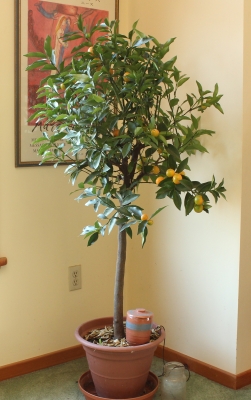
Potted kumquat
middle of the nineteenth century that plant explorers pressed inland to open wide the treasure chest of wild and cultivated plants, many of which have found their way into my garden. These plant explorers are honored in plants that bear their names. Fortunella, or kumquats (the genus was changed recently, with kumquats now in Citrus), named for Robert Fortune. I grew kumquats, wintering them indoors at a sunny window, for many years. Citrus meyerei, the Meyer lemon, named for Frank Meyer; my two Meyer lemon plants, also at sunny windows, are just beginning to send out new shoots, soon, with flowers.
(There is a darker side to “East meets West.” Up until the middle of the 19th century, Japan was isolationist, which was not to the liking of U.S. commercial interests. President Millard Fillmore enlisted “Admiral” Matthew Perry to force his boats into Japan’s Edo Bay to intimidate the Japanese into opening their ports to American trade, as well as other concessions. This gunboat diplomacy was successful.)
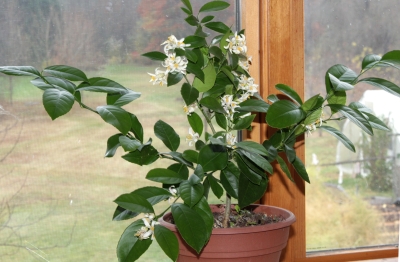
Meyer lemon in bloom
Trans-Pacific Cousins
From the Far East came plants for which we had no counterparts, plants such as the gingko tree. There also came plants more, or at least equally, valuable as related plants found here. We have our redcedar (Juniperus virginiana); from China comes Chinese juniper (J. chinensis). Our redcedars turn drab brown in winter, but the Chinese species remain lush green throughout the year.
Common witchhazel (Hamemalis virginiana) and vernal witchhazel (H. vernalis) are understory shrubs of American forests; Asian forests likewise have two witchhazel
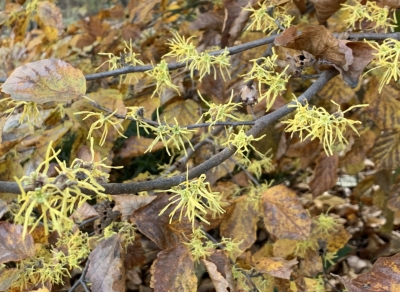
Arnold’s Promise witchhazel, today
species: Chinese (H. mollis) and the Japanese (H. japonica). The Asian species blossom at different times than the American species, so are useful for extending the period of witchhazel bloom. My Arnold’s Promise variety of witchhazel, a hybrid of the Chinese and the Japanese species, is in bloom right now although blooms often wait until midwinter to open
Where East really does meet West in gardening is in hybrids of Eastern and Western species. The hybrid tea rose, common in American gardens from New England to the Southwest, is one example. “Tea” in the name traces back to a tea-scented rose (Rosa gigantea) from China. For centuries, the Chinese hybridized this summer-flowering climber having huge, yellow flowers with a dwarf form of another species, R. chinensis. In the nineteenth century these hybrids were further hybridized with European roses to make hybrid tea roses.
Pest Control
American plant breeders sometimes have had to look across the Pacific to find plants with resistance to a disease originally brought to America from the East. Chestnut blight turned up at New York’s Bronx Zoo in 1906, and within fifty years, the tops of American chestnuts (Castanea dentata) were dead or dying in seven million acres of Appalachian forests. The roots, which are not affected by the blight, keep sprouting new shoots, which then die after a few years, but keep the blight fungus “fed.”
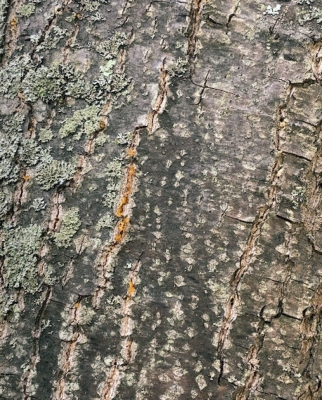
Blight on chestnut bark
Japanese chestnut (C. crenata) and Chinese chestnut (C. mollisima) evolved with the blight and show some resistance to it, so have been hybridized with the American species to produce blight-resistant trees, such as the variety Sleeping Giant. These trees lack the grandeur of the American chestnut, but they do make larger nuts. My chestnuts, the varieties Colossal, Marigoule, and Precoce Marigoule, are hybrids of European chestnut (C. sativa) and Japanese chestnut. They’re all blight resistant, but resistance is a matter of degree. My Colossal is finally succumbing to blight.
Dutch elm disease entered America via Europe, but entered Europe from Asia, probably about the time of World War I. Once again, Asian elm species — Chinese elm (Ulmus parviflora) and Siberian elm (U. pumila) — are resistant to the disease. Hybridization has produced such disease-resistant varieties as Patriot and Accolade.
Plants of Asia even have been useful in providing resistance to diseases not originating in Asia. Fireblight disease of pears was first noted in New York’s Hudson Valley at the end of the eighteenth century. Some Asian pear species are resistant to fireblight. Over a hundred years ago, hybrids between Asian and European pears that showed some resistance to blight were produced, at first by accident. These original hybrids did not taste very good, but did make pear-growing possible in blight-prone southeastern U.S.
The story isn’t yet over. Expeditions still return from such areas as remote villages and forest of China and the Himalayas to yield “new” plant treasures.
GIFT IDEAS
/2 Comments/in Books/by Lee ReichGreat Gift Ideas! Gardening books, of course. All available from the usual sources as well as, signed, right from me, here.
Weedless Gardening: Not only weedlessness; also lots of information on drip irrigation, making or buying compost, cover crops, timing and details for individual vegetables, tree planting, fertilization, and soil testing.  I’ve used this weed-less system for over 25 years! $10.95
I’ve used this weed-less system for over 25 years! $10.95
Growing Figs in Cold Climates: Five methods for growing figs in cold climates, pruning techniques, best varieties, harvesting, and  ways to hasten ripening. $24.99
ways to hasten ripening. $24.99
The Pruning Book: Reasons to prune, tools of the trade, how plants respond to being pruned, and details on just pruning just about every plant you can imagine, from ornamental trees and bushes, to fruit and nut trees, to houseplants and perennials. A final section delves into specialized techniques such as topiary, bonsai, and espalier. $29.95
from ornamental trees and bushes, to fruit and nut trees, to houseplants and perennials. A final section delves into specialized techniques such as topiary, bonsai, and espalier. $29.95
Landscaping with Fruit: How to choose what to grow depending on your region and particular pest or climate problems, and details for individual plants 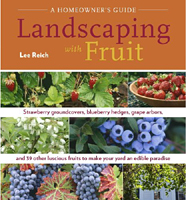 (the ornamental value, how easy they are to grow, what they taste like, varieties). Also a chapter on landscape design basics. $19.95
(the ornamental value, how easy they are to grow, what they taste like, varieties). Also a chapter on landscape design basics. $19.95
A Northeast Gardener’s Year: Month by month, chapter by chapter, in the garden. Each chapter begins with a snippet of borrowed poetry to set the tone, followed by a 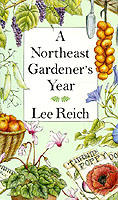 short description of what is going on plantwise. From there we are left to the whims and vagaries of the weather and the weeds, the unfolding of blossoms and ripening of fruits, perhaps the cry of a plant begging to be repotted — any and all topics gardenwise. $17.00
short description of what is going on plantwise. From there we are left to the whims and vagaries of the weather and the weeds, the unfolding of blossoms and ripening of fruits, perhaps the cry of a plant begging to be repotted — any and all topics gardenwise. $17.00
The Ever Curious Gardener: Using a Little Natural Science for a Lot Better Garden: An irreverent romp through the natural science of plants and soil, ideal for  everyone from newbies to experienced gardeners whose curiosity at the wonders of cultivation grows deeper and stronger with each season. How to maximize flavor and nutrition; how to help plants outwit drought; making the best sse of compost; etc, etc. $18.99
everyone from newbies to experienced gardeners whose curiosity at the wonders of cultivation grows deeper and stronger with each season. How to maximize flavor and nutrition; how to help plants outwit drought; making the best sse of compost; etc, etc. $18.99
Grow Fruit Naturally: How to successfully grow fruits that are delicious and nutritious without toxic chemicals. Covers planning, propagation, pruning,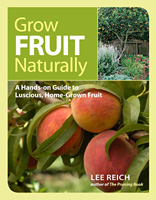 pest control, storing your bounty, and growing fruit plants in containers. Details on over 30 fruits and how to reap their bounty. $24.95
pest control, storing your bounty, and growing fruit plants in containers. Details on over 30 fruits and how to reap their bounty. $24.95
FILBERT NUTS OR HAZELNUTS?
/16 Comments/in Planning/by Lee ReichSpecies Matter; Varieties Matter
You say “tomayto,” I say “tomahto.” You say “filbert,” I say “hazelnut.” (“Filbert” is from St. Philibert, to whom August 22nd, is dedicated and which is the day of first ripening of hazelnuts in England.) Although hazelnuts originally referred to native American filberts, hazelnut and filbert are now equivalent.
It’s been over twenty years since I planted my first hazelnuts. Fortunately, hazels bear quickly, often within 3 or 4 years. Unfortunately, a disease called eastern filbert blight can decimate the trees, and not begin to do so for about a decade. Our native hazels (Corylus americana), having evolved with the blight, are resistant. Not so for European hazels, which are the hazelnuts of commerce.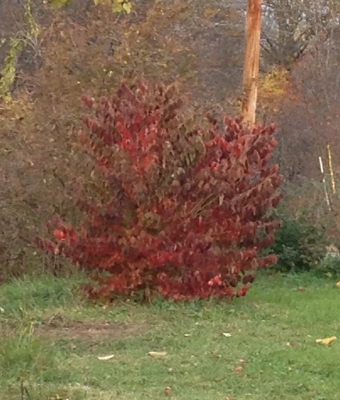
My first planting was of our native hazel, which I planted for beauty and for nuts. It did turn out to be an attractive, suckering shrub that lit up fall with its boldly colored leaves. The nuts themselves were less notable: small and not very good tasting.
Next I planted a few old varieties of hybrid hazels, Graham, Gellatly, and Halls Giant, followed, a few years later by Tonda di Giffoni, Lewis, and Clark. All were billed as blight resistant and did quite well. In the 1960s eastern filbert blight made its way to the Pacific Northwest, the hotbed of commercial hazelnut production in the U.S. (providing 99 percent of domestic hazelnuts), which prompted breeding of resistant varieties. Lewis and Clark are two such varieties. Two more such varieties, Santiam and Yamhill, were added to my collection 11 years ago.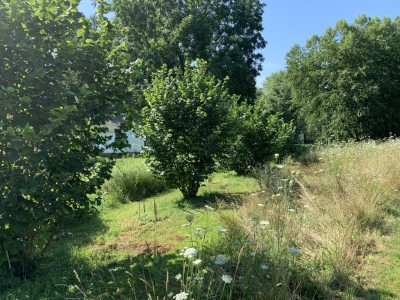
Right on schedule after about ten years, black pustules of blight began to show up on branches, which start to die, then finish. But the varieties I planted were blight resistant, you say. Resistance is a matter of degree (“immune” means no disease), and the varieties I planted evidently were not sufficiently resistant.

This doesn’t at all reflect poorly on breeders of these not-quite-resistant-enough hybrids. The blight fungus is capricious, changing with location and, perhaps, over time. I dug up and out all the nonproductive, diseased plants.
But I like filberts. Enter a few breeders breeding filberts right here in the northeast. One is Dr. Tom Molnar of Rutgers University, from whom I got a few selections (with nonluscious, early selection names like CR X R03P26 and CR X R11P07), which I planted back in 2014. And Jeff Zarnowski, of Z’s Nutty Ridge Nursery. And others. So now I grow Geneva (aka Gene, from Grimo Nut Nursery), Truxton, Dorris (another selection from Oregon), Raritan (a more advanced selection from Rutgers), as well as my original Rutgers plants.
I’m ready to cull again any varieties that catch blight or whose nuts are too small. For wherever plants are culled, I have potted plants of Monmouth, Hunterdon, and Somerset — all advanced Rutgers selections — waiting in the wings.
Streamlining Processing (On a Very Small Scale)
As with fruits in general, this year was also the best ever for nuts that I grow. Even the English walnuts (Juglans regia) bore a crop this year, their first substantial crop, all from 6 walnuts I planted back in 2006. I didn’t have high hopes for walnuts because they are susceptible to anthracnose disease, late frosts, and squirrels, which could conveniently harvest the nuts from the overhead squirrel highway along the road.
And the filberts — oodles of them. Mostly, we just shell and eat them. That’s fine. But for cooking with them or concocting a delicacy such as, say, fig-hazelnut jam, shelling nuts one at a time is too slow.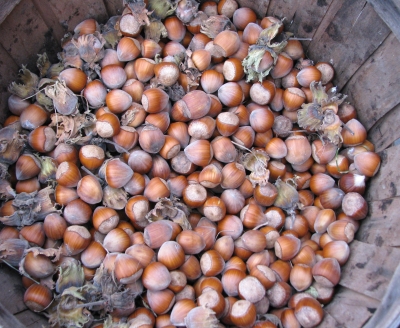
A quick web search turned up a couple of very elegant, home made shellers that work reasonably well. Luckily, before I delved too deeply in how I was going to fabricate one of these out of metal, I did a web search and found one available for about $30.
(These kitchen counter hazelnut sheller are manufactured in Turkey, which grows 70 percent of the world’s hazelnuts. Want another fun fact? Twenty-five percent of the world’s production goes into making Nutella and Ferrero Rocher, both hazelnut and chocolate confections made by the Luxemburger company Ferraro.)
One problem with the sheller is that it needs adjustment for nut size, so it is recommended to do some sorting into size ranges before running nuts through the sheller. This I could make myself, easily. Basically, it is an open wooden box whose bottom has 3/8 inch square, wooden dowels spaced 5/8 inch apart, which is pretty much the size of my largest hazelnuts in the shell. The corners of the box are joined by hinges so that the sides can be moved to deform the shape. As the box deforms increasingly to a parallelogram, the distance between the dowels decreases. A pegged slat from one side of the box to n adjacent side holds the box to the desired shape and dowel spacing.
So I just adjust the box to the smallest dowel spacing needed, about 3/8 inch apart, dump on a bunch of nuts, and shake. Then I move the spacing up to about 1/2 inch, then shake again. And finally, move spacing to 5/8 inch, and . . . well, you know.

I could be on my way to hazelnut butter, chopped hazelnuts sprinkled on everything, that fig-hazelnut jam, perhaps even home made Nutella. No rush. Once sufficiently dried (to 6 percent moisture, which takes a couple of weeks), hazelnuts store well in their shells for over year. Shelled and refrigerated, they keep for for about six months

